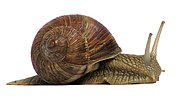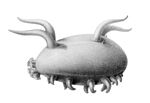The respiratory system of gastropods varies greatly in form. These variations were once used as a basis for dividing the group into subclasses. The majority... 7 KB (936 words) - 20:18, 15 September 2022 |
Pneumostome (category Invertebrate respiratory system) a respiratory opening of the external body anatomy of an air-breathing land slug or land snail. It is a part of the respiratory system of gastropods. It... 3 KB (324 words) - 04:05, 1 December 2023 |
 | Aquatic respiration (section Control of respiration) oxygen-capturing molecule. The respiratory system of gastropods can include either gills or a lung. Aquatic arthropods generally possess some form of gills in which gas... 16 KB (1,949 words) - 16:22, 4 January 2024 |
digestive system of gastropods proboscis#Gastropods radula odontophore hepatopancreas = digestive gland diverticulum (mollusc) style (zoology) Respiratory system... 6 KB (518 words) - 13:04, 24 February 2024 |
 | Gastropoda (redirect from Diversity of gastropods) reproductive adaptations of gastropods vary significantly from one clade or group to another, so stating many generalities for all gastropods is difficult. The... 48 KB (5,023 words) - 03:16, 7 April 2024 |
 | Ctenidium (mollusc) (category Invertebrate respiratory system) Polyplacophorans (chitons), and in aquatic gastropods such as freshwater snails and marine snails. Some aquatic gastropods possess one ctenidium known as monopectinate... 2 KB (156 words) - 00:31, 2 October 2022 |
 | Siphon (mollusc) (category Invertebrate respiratory system) order to hunt for food. Marine gastropods that have a siphon are either predators or scavengers. Although in gastropods the siphon functions perfectly... 12 KB (1,224 words) - 15:08, 25 October 2023 |
 | Dog anatomy (redirect from Respiratory system of the dog) the angle of the brain within the skull, regardless of the brain size or the body weight of the dog. The respiratory system is the set of organs responsible... 55 KB (6,712 words) - 04:44, 19 April 2024 |
 | Mollusca (redirect from Respiratory systems of molluscs) have an open circulatory system and kidney-like organs for excretion. Good evidence exists for the appearance of gastropods, cephalopods, and bivalves... 93 KB (9,438 words) - 10:13, 14 April 2024 |
 | Invertebrate (section Respiratory system) of invertebrate species, including annelids, molluscs, nematodes and arthropods. One type of invertebrate respiratory system is the open respiratory system... 41 KB (4,736 words) - 08:12, 11 April 2024 |
 | Slug (category Gastropod anatomy) applies to gastropods that have a coiled shell large enough that they can fully retract their soft parts into it). Various taxonomic families of land slugs... 41 KB (4,223 words) - 20:40, 27 April 2024 |
 | Sea cucumber (section Respiratory system) miniature hearts to pump blood around the haemal system. Additional vessels surround the respiratory trees, although they contact them only indirectly... 60 KB (6,642 words) - 20:08, 18 April 2024 |
arch of a fish (on the inner surface of the opercle, near the junction of the preopercle) as well as a reduced "false" gill in some gastropods. In teleost... 2 KB (157 words) - 19:22, 29 August 2023 |
 | Nematode (redirect from Excretory systems of nematodes) Phasmarhabditis hermaphrodita which is a lethal parasite of gastropods such as slugs and snails. Some members of the genus Steinernema such as Steinernema carpocapsae... 69 KB (7,446 words) - 02:45, 19 April 2024 |
SARS-CoV-2, severe acute respiratory syndrome coronavirus 2 COVID-19, coronavirus disease 2019 Corona may also refer to: Corona, a part of a cornice The Corona... 6 KB (780 words) - 00:19, 28 March 2024 |
 | Bivalvia (redirect from Reproductive systems of bivalves) animals with paired valves include certain gastropods (small sea snails in the family Juliidae), members of the phylum Brachiopoda and the minute crustaceans... 121 KB (13,138 words) - 20:16, 23 April 2024 |
 | Telescopium telescopium (category Gastropods of Asia) proboscis protrusion. Telescopium telescopium respiratory system works in the same way to other semi-tidal gastropods in that it gets oxygen from water passing... 23 KB (2,609 words) - 01:15, 1 January 2024 |
This list of gastropods described in 2017 is a list of new taxa of snails and slugs of every kind that have been described (following the rules of the ICZN)... 82 KB (7,651 words) - 07:20, 29 April 2024 |
 | Starfish (redirect from Circulatory systems of starfish) thin-walled protrusions of the body cavity that reach through the body wall and extend into the surrounding water. These serve a respiratory function. The structures... 104 KB (11,276 words) - 19:10, 17 April 2024 |
 | Crinoid (section Water vascular system) as both a respiratory and an excretory system. Oxygen is absorbed primarily through the tube feet, which are the most thin-walled parts of the body, with... 43 KB (4,559 words) - 15:27, 27 March 2024 |
 | Cephalopod (redirect from Reproductive system of cephalopods) intelligent of the invertebrates and have well developed senses and large brains (larger than those of gastropods). The nervous system of cephalopods... 133 KB (14,920 words) - 18:15, 21 April 2024 |
 | Abalone (section Structure and properties of the shell) characterized by several open respiratory pores in a row near the shell's outer edge. The thick inner layer of the shell is composed of nacre, which in many species... 62 KB (5,483 words) - 17:18, 29 March 2024 |
 | Octopus (section Circulatory system) tissue lattices support the respiratory muscles and allow them to expand the respiratory chamber. The lamella structure of the gills allows for a high... 114 KB (11,943 words) - 13:01, 29 April 2024 |







